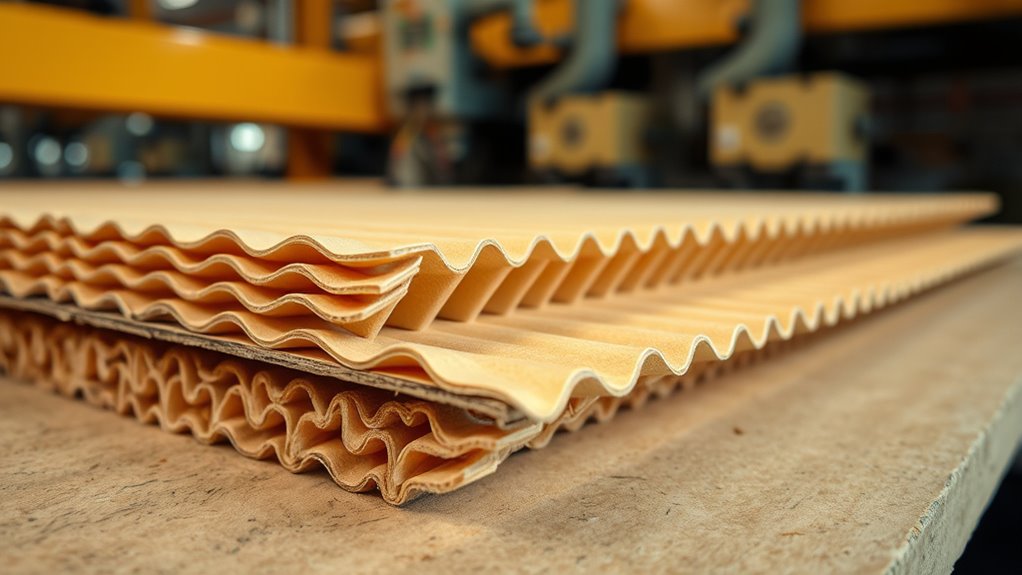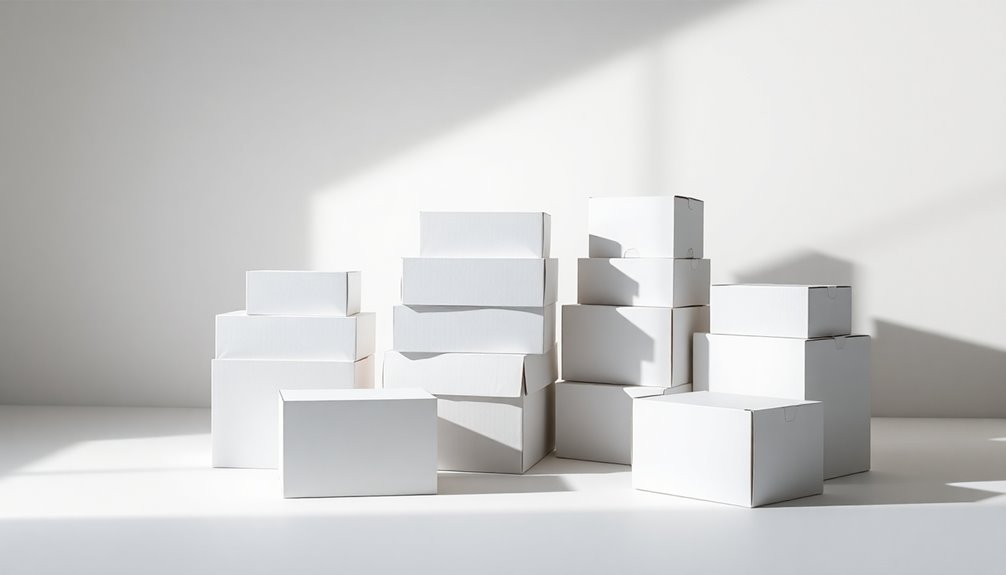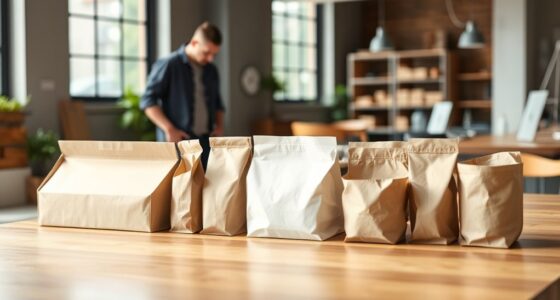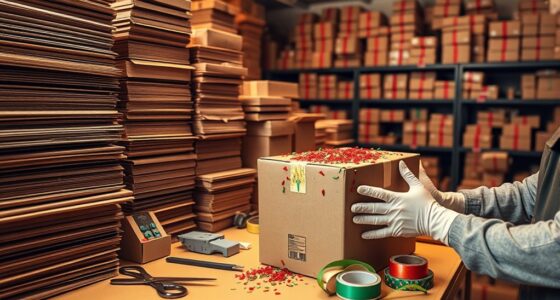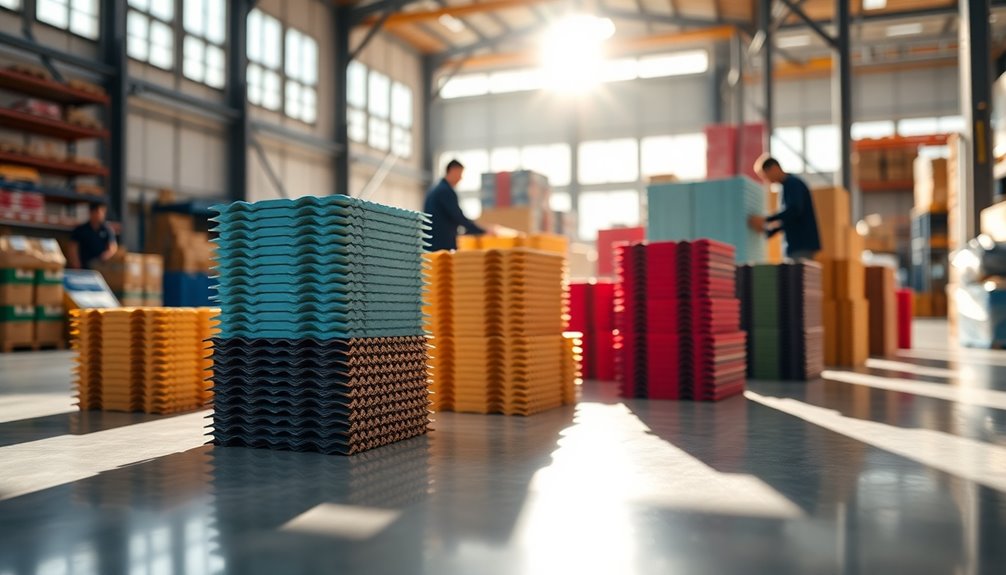You start by recycling paper and wood fibers, cleaning and processing them into pulp. Next, you form the corrugated medium by embossing and shaping flutes, and produce strong linerboards from raw pulp. These layers are then bonded together using adhesive, with careful alignment and shaping. Finishing touches like coatings and quality checks guarantee durability and appearance. If you want to know every detail, there’s more to discover about how the process transforms raw materials into sturdy boxes.
Key Takeaways
- Recycled paper and wood fibers are cleaned, de-inked, and processed into pulp to promote sustainability.
- Pulp is spread into sheets, embossed if needed, and formed into fluted medium using corrugating rolls.
- Thin, strong linerboards are produced from pulp through pressing, drying, and recycling techniques.
- The fluted medium is bonded between linerboards with adhesive, shaped, and cut into specific sizes.
- Final finishing includes coating, quality inspection, and trimming to produce durable corrugated boxes.
Raw Material Preparation and Pulping
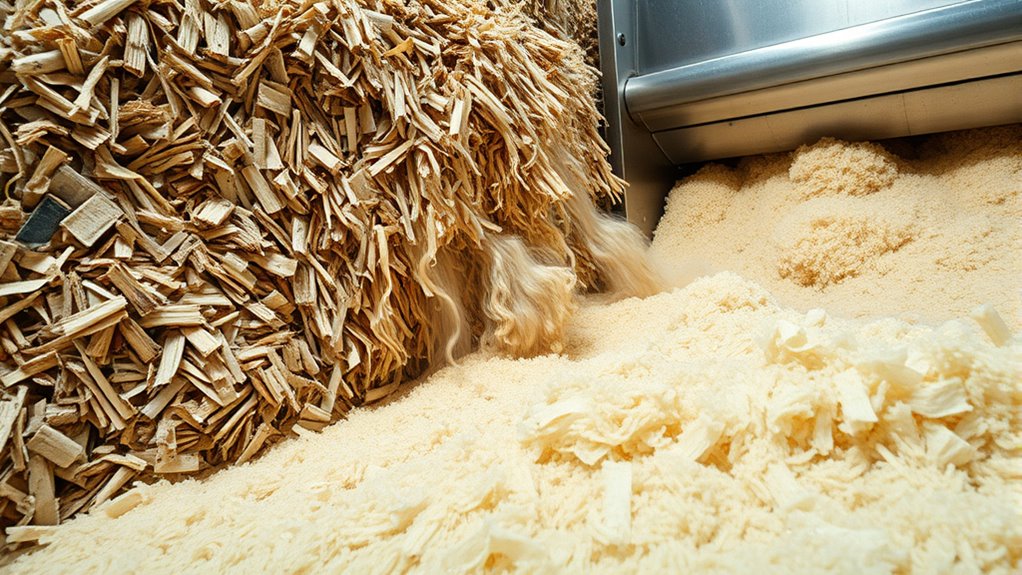
Have you ever wondered how raw materials are transformed into the pulp used for corrugated cardboard? It all begins with raw material preparation, where recycled paper and wood fibers are collected. Recycling techniques are essential here, as they help reduce waste and decrease the environmental impact of manufacturing. The collected materials are cleaned, de-inked, and processed into a slurry through pulping, breaking down fibers into manageable sizes. This step not only conserves natural resources but also minimizes landfill waste. By using recycled fibers, manufacturers lower their environmental footprint, promoting sustainability. The pulp then moves on to the next stage, where it’s refined and prepared for forming the corrugated medium. This process demonstrates how eco-conscious practices are integrated into the early stages of corrugated cardboard production.
Forming the Corrugated Medium
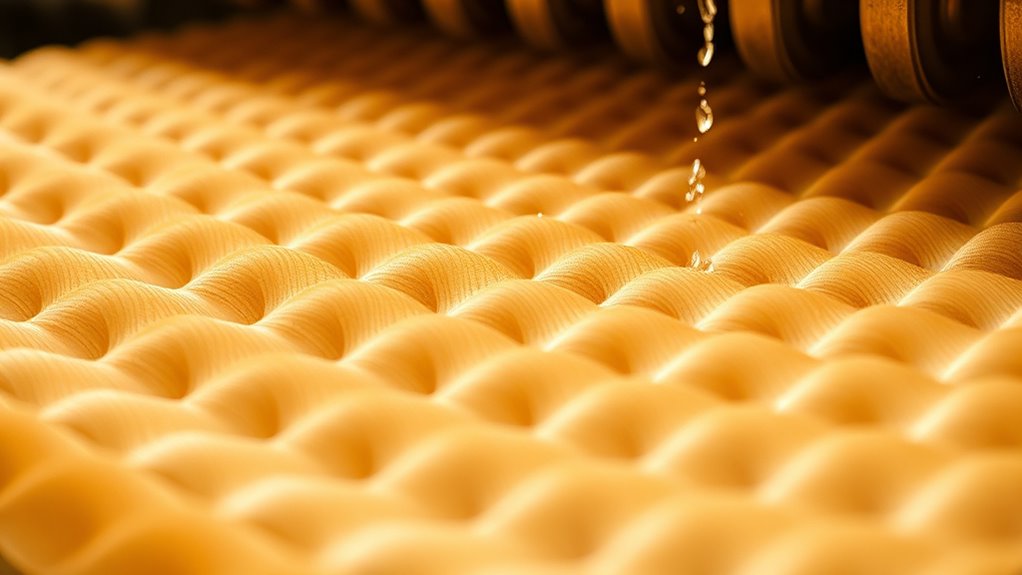
How exactly is the corrugated medium formed from the prepared pulp? You begin by spreading the pulp onto a moving belt, creating a continuous sheet. This sheet passes through embossing techniques to add texture or patterns if desired. Next, the medium is shaped by a corrugating rolls that form the characteristic flutes. Adhesive application occurs between the fluted medium and the liners to bond them securely. Additionally, the use of advanced manufacturing techniques improves durability and efficiency in production. Here’s a quick overview:
| Step | Method | Purpose |
|---|---|---|
| Pulp spreading | Continuous sheet | Uniform thickness |
| Embossing techniques | Patterned rollers | Adds texture and strength |
| Corrugating rolls | Form flutes | Creates the wave structure |
| Adhesive application | Glue rollers | Bonds medium to liners |
| Final shaping | Pressing and drying | Ensures proper adhesion and shape |
Producing the Linerboards
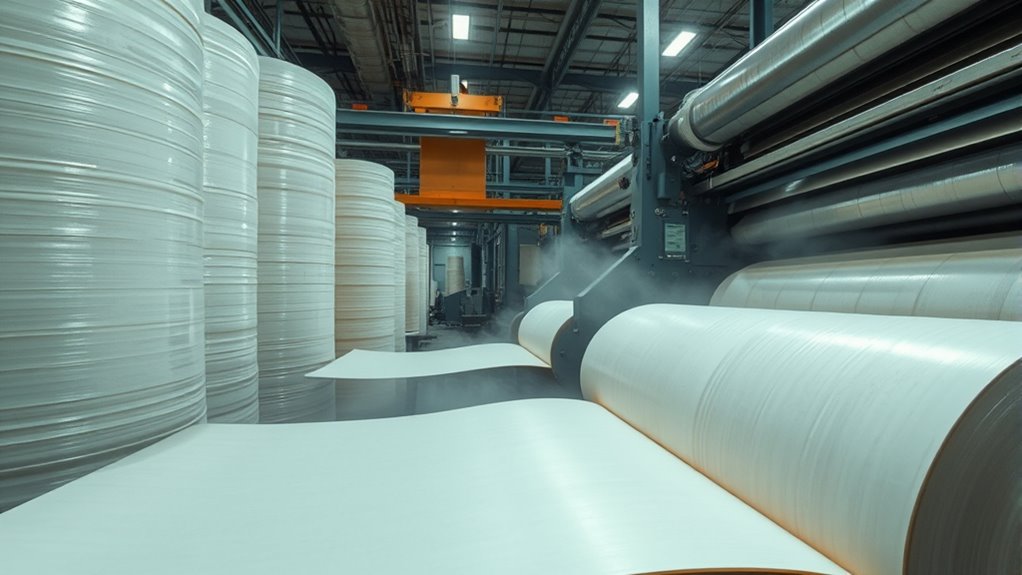
Producing linerboards involves transforming raw paper pulp into thin, strong sheets that serve as the outer layers of corrugated cardboard. You’ll use specialized machines to press and dry the pulp into smooth, durable sheets. Recycling methods play a key role here, allowing you to reuse old paper and reduce waste. This process not only conserves resources but also minimizes environmental impacts like deforestation and energy consumption. You’ll need to carefully control moisture and temperature to guarantee quality. Additionally, incorporating recycled fibers helps lower carbon footprints. Proper handling of chemicals and waste is crucial for eco-friendly production. By adopting sustainable practices, you can produce high-quality linerboards while protecting the environment and supporting responsible manufacturing. Advances in automation technology continue to improve production efficiency and quality control in the manufacturing process.
Assembling the Corrugated Sheets
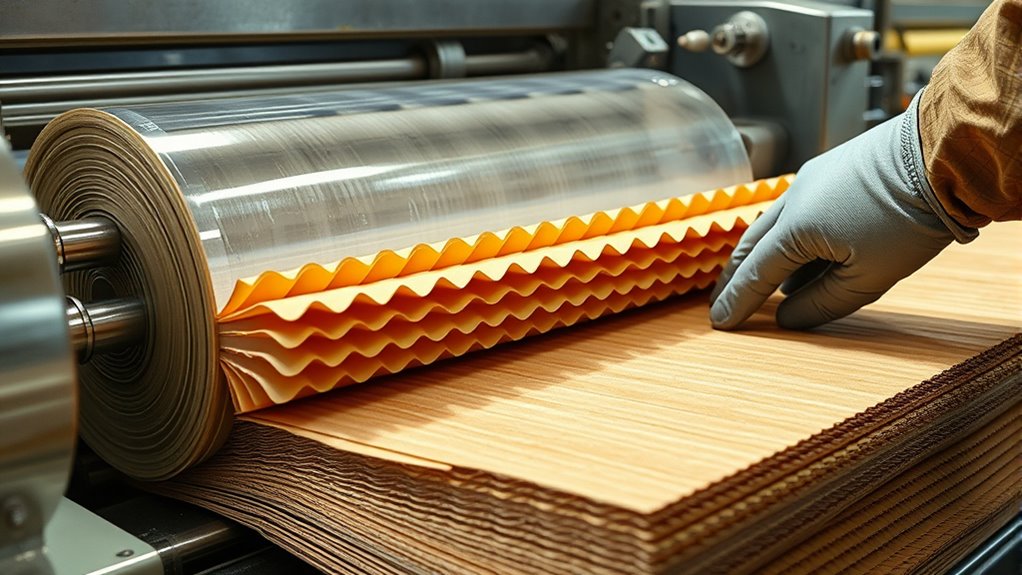
Assembling the corrugated sheets involves precisely joining the fluted medium between two linerboards to create a strong, durable structure. You’ll start by applying adhesive evenly on the linerboards, ensuring a solid bond. The fluted medium is then carefully aligned and pressed between the liners. To enhance efficiency, die cutting techniques are used to shape the sheets precisely, matching box sizes and designs. Here’s a quick overview:
| Step | Technique | Purpose |
|---|---|---|
| Adhesive application | Spray or roller | Secure the layers |
| Flute alignment | Mechanical guides | Precise positioning |
| Die cutting | Die cutting presses | Custom shapes and sizes |
| Compression | Hot or cold presses | Final bonding and shaping |
This process guarantees your corrugated sheets are ready for the next stage. Understanding the manufacturing process ensures optimal quality and performance of the final product.
Finishing and Quality Control Processes
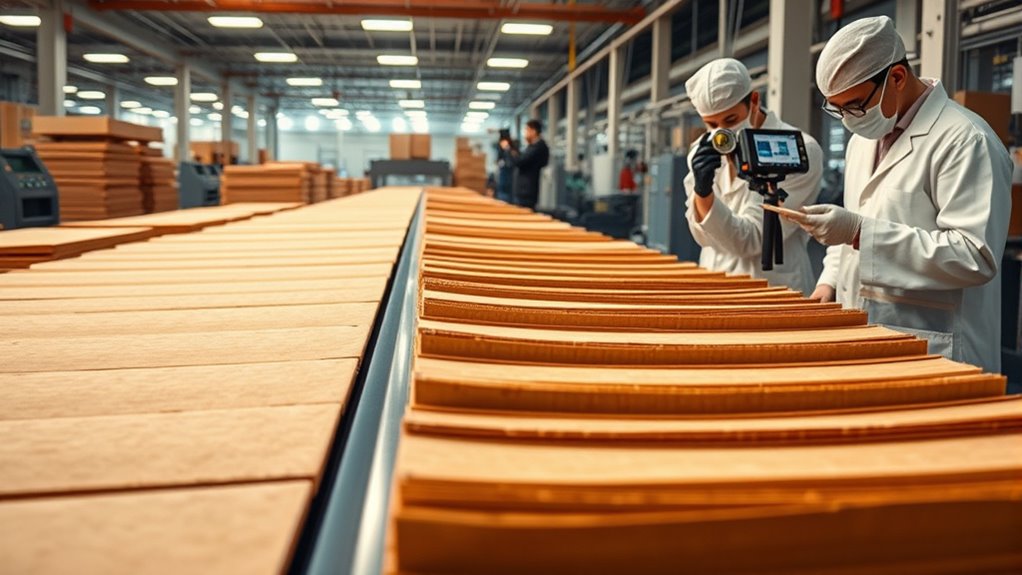
Once the corrugated sheets are assembled, the finishing and quality control processes guarantee the product meets industry standards and customer expectations. You’ll see coating techniques applied to enhance durability and surface finishing to improve appearance. These steps guarantee the boxes resist moisture, tearing, and other stresses during shipping and handling. You might inspect for surface defects, such as dents or uneven coatings, and verify dimensions for precise fitting. Coating techniques can include lamination or varnishing, adding extra strength and a clean look. Surface finishing also involves trimming excess material and applying logos or branding. Implementing quality control processes ensures consistency and helps identify areas for improvement, which is vital for continuous development. These processes are vital to deliver a high-quality, reliable product that satisfies both industry requirements and customer needs. Ensuring superior finishing boosts the box’s performance and overall customer satisfaction. Developing a thorough quality control process fosters a mindset of embracing failure as an opportunity to improve, leading to more innovative and resilient packaging solutions. Additionally, incorporating cybersecurity measures can help protect digital data associated with production and supply chain management, safeguarding sensitive information from cyber threats. Moreover, integrating surface defect detection technologies can further enhance the quality assurance process by automatically identifying flaws during production.
Frequently Asked Questions
How Does Environmental Sustainability Influence Corrugated Cardboard Manufacturing?
Environmental sustainability greatly influences corrugated cardboard manufacturing by encouraging eco-friendly practices. You can reduce your environmental impact by choosing products made from renewable resources and supporting companies that prioritize sustainable methods. Implementing recycling, minimizing waste, and using eco-conscious materials help protect the environment. Embracing these practices not only benefits the planet but also appeals to eco-aware consumers, ensuring your business remains responsible and competitive in a growing green market.
What Are the Innovations in Recycling and Reuse of Corrugated Materials?
Did you know that over 90% of corrugated cardboard is recycled globally? You can contribute by supporting innovations like biodegradable coatings, which make recycling even easier, and reusable templates that extend the life of packaging. These advancements help reduce waste and promote sustainability. By choosing products with these features, you actively participate in a circular economy, making a positive environmental impact every time you reuse or recycle corrugated materials.
How Do Different Types of Corrugated Boards Impact Product Protection?
You’ll notice that different types of corrugated boards, like single, double, or triple-wall, impact product protection based on fiber strength and flute profiles. Thicker flute profiles and stronger fibers provide better cushioning and rigidity, safeguarding fragile items during transit. By choosing the right combination, you guarantee your products are well-protected, reducing damage and returns. Your selection directly influences durability and shipping success, making it essential to understand these variations.
What Are the Safety Measures During Large-Scale Corrugated Production?
Imagine safety as the foundation of your workday. During large-scale corrugated production, you must follow strict machinery protocols and prioritize worker safety. You’re responsible for using protective gear, adhering to operational guidelines, and staying alert around heavy equipment. Regular training and safety audits act as your shield, reducing risks. When safety measures are in place, you create a secure environment where productivity thrives, and accidents become a thing of the past.
How Does Customization Affect the Manufacturing Process of Corrugated Boxes?
Customization options considerably impact the manufacturing process of corrugated boxes by requiring greater manufacturing flexibility. When you choose custom sizes, designs, or features, you’ll need adaptable machinery and processes to meet specific specifications efficiently. This can lead to adjustments in production lines, increased planning, and sometimes longer lead times. However, it allows you to create unique, tailored packaging that better fits your needs, enhancing product presentation and customer satisfaction.
Conclusion
Now you see how corrugated cardboard transforms from a simple pulp into a sturdy, protective box. It’s like watching raw ingredients dance through a factory’s heartbeat, weaving together layers of strength and flexibility. Each step is a brushstroke in a masterful painting, turning humble paper into a reliable guardian for your goods. Next time you see a box, remember the intricate journey it’s traveled — a silent hero built from nature’s finest fibers.

